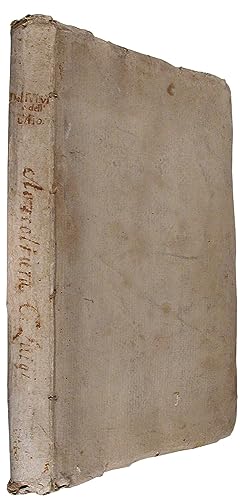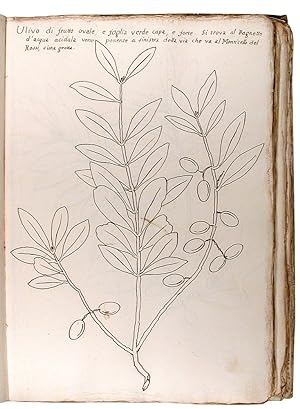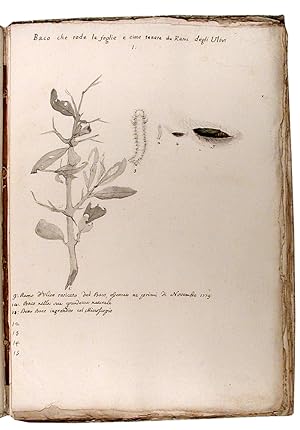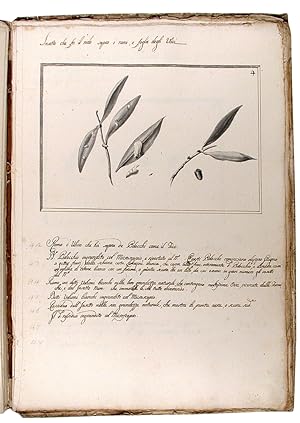About this Item
Delle specie diverse d'Olivi che si trovano ne Monti della Fattoria d'Agnano Territorio Pisano, spettante a S(ua) A(ltezza) S(erenissima) etc. Con osservazioni sopra le specie degli Olivi ancora di Lucca, Pietrasanta, Montignoso, Massa, Sarzana, Lunigiana, e Riviere di Genova, ad effetto di rilevare quali siano quelle Specie che servono a produrre l'olio fino, e quali quelle che corrispondono alle Specie degli Antichi.[Of the different species of Olive trees that can be found on the mounts of Agnano, in the territory of Pisa, belonging to H(er) R(oyal) H(ighness) etc., with observations also on the species of Olive trees of Lucca, Pietrasante, Montignoso, Massa, Sarzana, Lunigiana and of the two Rivieras of Genoa, with the aim of finding out which are the Species that can be used for the production of the 'olio fino' and which are those that correspond to the Species of the Ancients].[Florence/ Fivizzano], 1770-1784. Folio (385 x 270mm). Leaves 126, including some blanks and 107 mostly full page drawings, in pen and ink, a few in pencel only, and some in grey wash or watercolour, a few plates are numbered but not bound in consecutively. Contemporary or near contemporary boards, spine with ink inscription 'Dell'Ulivi e dell'Olio, Agricoltura Cte Luigi', and a fragment of letter addressed to Conte Luigi Fantoni, in Florence pasted in on verso of frontcover, as well as a later added competition regarding the description of olive trees and olive oil of Tuscany, sponsored by the Accademia dei Georgofili in 1803 and a loosely inserted one dated 1802. This manuscript serves as priceless testimony to the growing interest paid, above all in Tuscany, to olive growing and the study of olive oil production techniques throughout the eighteenth century. It was during this time that efforts grew to better understand the history of the olive tree and its multitudinous varieties, as well as the ways in which it was propagated, cared for and fertilized.Around the year 1704 the botanist Pier Antonio Micheli had already begun to dabble in the study of olive trees, drafting a series of observations compiled in manuscript (E. Baldini and S. Ragazzini, Le varietà di ulico dell'agro fiorentino. Manoscritto inedito di Pietro Antonio Micheli, Florence: Accademia dei Georgofili, 1988).The moment in which interest in the cultivation of olive trees reached its height can be traced back to 1753, the year in which the Accademia dei Georgofili was founded in Florence. Numerous handwritten memoirs and manuscripts concerning the olive tree have been kept in their archives or published in the academy's periodical. It was the very same Accademia dei Georgofili to publicly announce a competition on August 29th, 1787 to determine the best "creation of one or more olive nurseries with at least 200 trees". The prize was given to Pietro Fanechi, a worker at the Tolomei farm in Scarperia, a small town in the area of Mugello.Outside of the confines of Tuscany, an important work to mention is the book published by Giovanni Presta at the royal press of Naples, the result of ten years of research. (Degli ulivi delle ulive, e della maniera di cavar l'olio o si riguardi di primo scopo la massima possibile perfezione, o si riguardi la massima possibile qualità del medesimo. Naples: Stamperia Reale, 1794.)Returning to the manuscript at hand the spine of the binding reads 'Dell'Ulivi e dell'Olio, Agricoltura. Cte Luigi' and a fragment of a letter addressed to Count Luigi Fantoni is found on the verso of the front cover and seems to confirm the true identity of the author as that of Count Luigi Fantoni.It is likely that the manuscript was ab antiquo a sort of rough draft on which Fantoni marked his observations and added information regarding each species after it had been analyzed.Of note is the presence of three different headings on the first sheet of the manuscript, almost as if Fantoni had modified the parameters of his research in the course of his work and was thus compe. Seller Inventory # 6814
Contact seller
Report this item
![]()




